Germany is a cycling nation. According to Statista, there are 81 million bicycles owned in Germany – that is almost one bike per resident! Next to leisure and holiday rides, Germans use their bikes as a general means of transportation and to commute to work, university, or school. This guide will explain the most essential cycling rules in Germany to stay safe and without any fines.
Get a roadworthy bike
Bicycles that you use in road traffic in Germany need to have certain equipment to be legally roadworthy. It is all about being visible in the dark at night and being able to stop abruptly.
According to the German Bicycle Association (ADFC), your bike should have these items:
- a white front light and a red backlight that are approved by the Straßenverkehrs-Zulassungs-Ordnung (StVZO). Make sure to search for the StVZO approval when searching for lights in a physical or online shop.
- a white reflector in the front and a red reflector in the back (which can be integrated with the light)
- functioning front and back-wheel brakes
- a bell
- reflector stripes around the tire or two orange reflectors on the spokes per wheel
- two yellow reflectors on each pedal
- Note: Speaking from experience, none of our bikes have the yellow reflectors on the pedals, and we have never been stopped or fined for it. Bike lights and functioning brakes, however, are absolutely crucial 😉. The lights and reflectors don’t have to be mounted on the bike during the daytime if they are removable.
If you don’t own a bike in Germany yet but are looking into buying one, be sure to read our below guide or watch our video on how to buy a bike in Germany.
Read Our Related Guide
What are the rules of riding a bicycle in Germany?
Cyclists in Germany need to follow the general traffic rules implemented by the road traffic regulations (Straßenverkehrsordnung).
The most important traffic rules for cyclists are:
1. Don’t drink and drive
Cycling is not a safe alternative to a car if you want to head home after a night out drinking alcohol. Since you are actively taking part in road traffic you are bound to strict fines when causing an accident or being controlled with alcohol in your blood.
Two legal alcohol limits are relevant:
- up to 0,3 per mille: Biking is legally ok as long as you don’t ride your bike without suspicious behavior and no accidents occur.
- from 1,6 per mille: Biking in such a state is considered a criminal offense with harsh consequences such as a fine of one net salary, 2 Flensburg points, and a medical-psychological evaluation (MPU). Should you not pass the MPU, your driver’s license will be revoked forever, and you can even be forbidden to ride a bicycle again.
A blood alcohol level in between those two limits can also result in fines, Flensburg points, and a temporary revocation of your driver’s license, depending on the circumstance.
So make sure to push your bike home or take a taxi after having had more than one drink not to create danger for yourself and others.
Read Our Related Guide
2. Know where to ride your bike
Cyclists in Germany need to use certain lanes and refrain from riding on others. We tell you the dos and don’ts.
Use Dedicated Bike Lanes
Whenever available, cycle on the dedicated bike lanes. Round blue signs with a white bicycle indicate mandatory cycling paths. They might be on the sidewalk or on the street. If you share a path with pedestrians, you need to respect and give way to them.
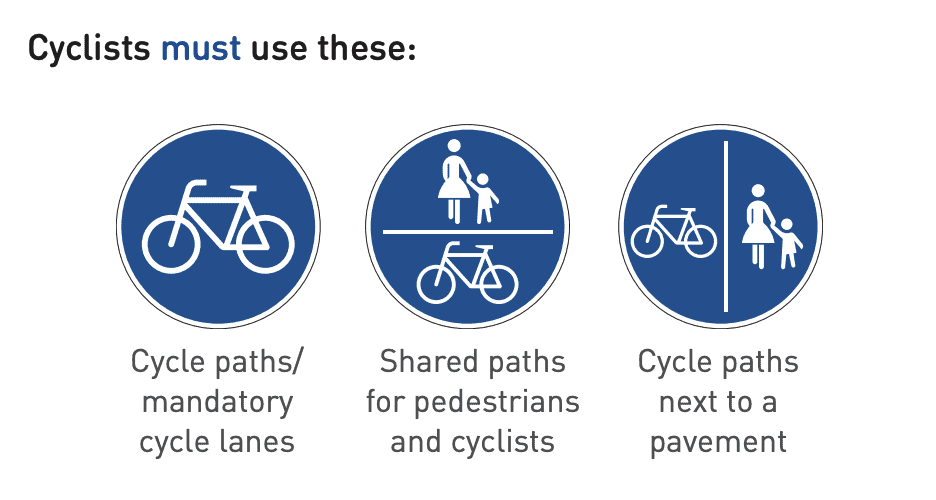
Never Cycle On the Sidewalk
Unless there is a dedicated bike lane on the sidewalk, you are not allowed to cycle on the sidewalk as an adult and you must cycle on the road with the traffic. You must always cycle on the right side of the road.
If you are cycling with your kids in Germany, make sure to also follow these rules for children:
- until the age of 8 must use the sidewalk.
- between 8 and 10 years old can choose whether to cycle on the sidewalk or road.
- above the age of 10 must use the road when there is no sidewalk available.
Never Cycle In Pedestrian Area
In city centers in Germany, you usually find larger pedestrian areas (Füßgänger-Zone). You are not allowed to cycle through them; instead, you need to get off your bike and push it through this area.
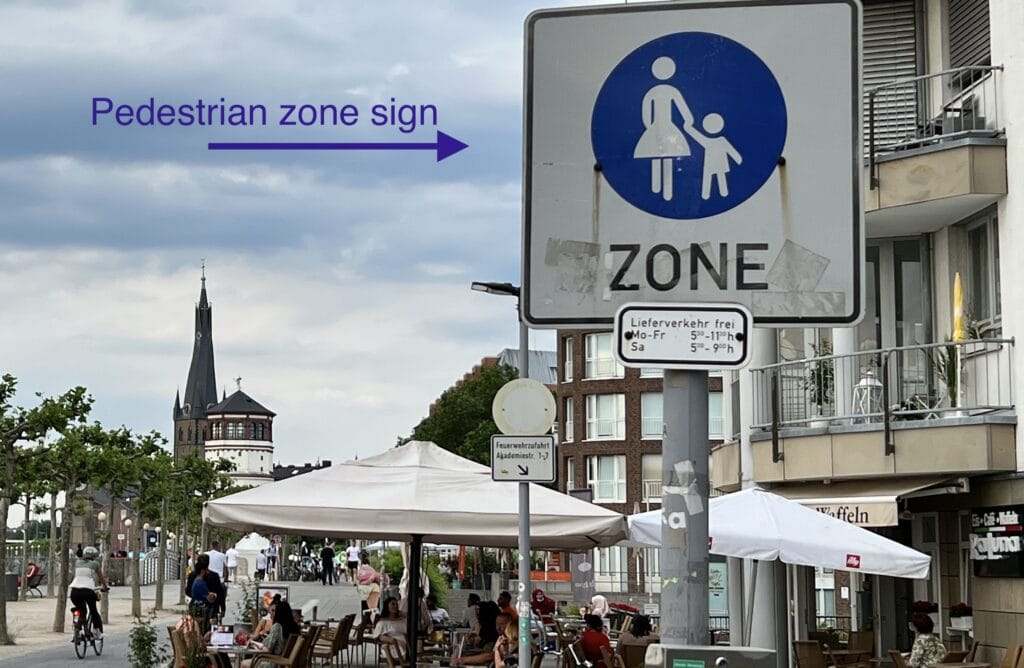
Only if you see the below white road sign with a bike and the word ‘frei‘ on it are you allowed to cycle through this area.
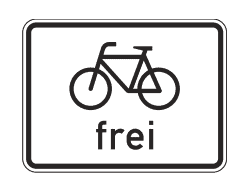
Source: German Road Safety
Never Cycle On The Autobahn Or Countryside Highways
The Autobahn and motorways are only for motorized vehicles that can drive faster than 60 km/h. Don’t ever enter one of those highways with your bicycle, as you will put yourself and others in danger.
You can identify these roads by these road signs:
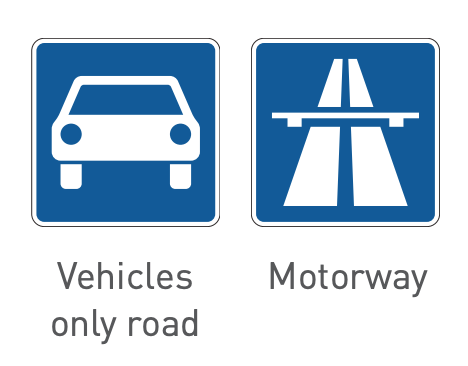
Source: German Road Safety
Never Cycle Against The Traffic Direction
You should always cycle with the flow of the traffic. There are two exceptions when you are allowed to go against the traffic:
- There is only one cycle path for both directions.
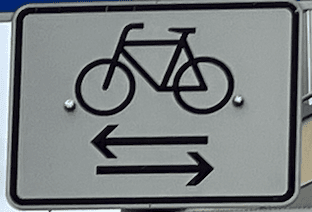
- A one-way street has the open for cyclists sign.
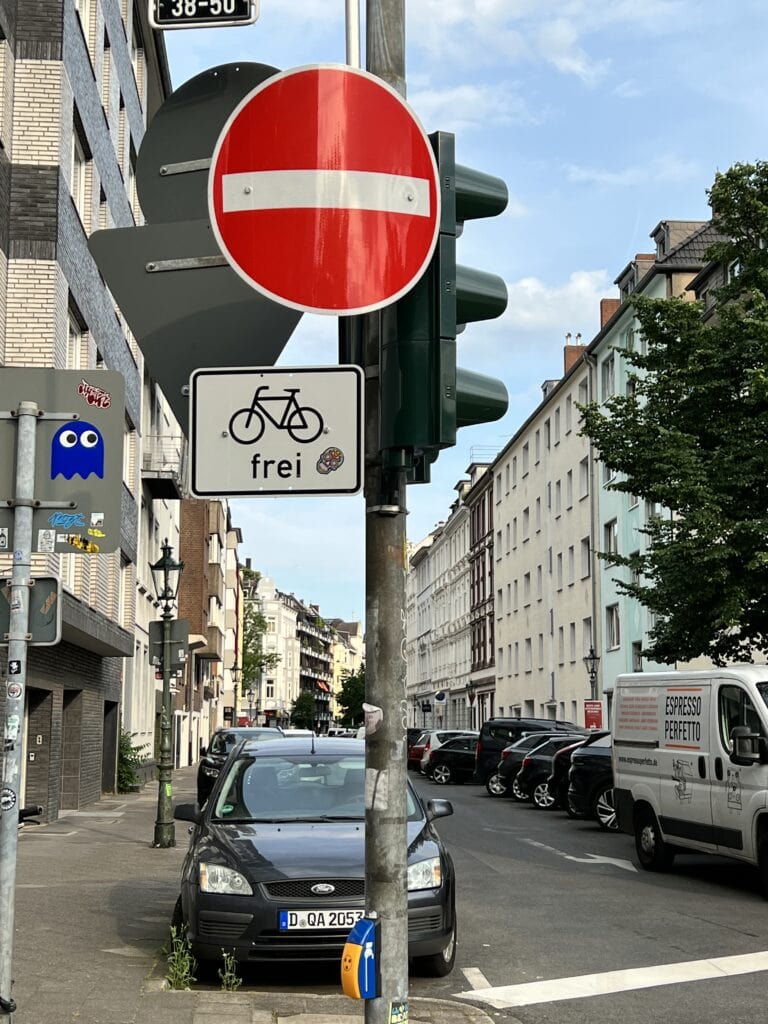
3. How to correctly make turns while cycling in Germany
Use Hand Signal Before Making A Turn
Whenever you would like to make a right or left turn while cycling, you always need to indicate your planned turn beforehand. You do so by stretching your right arm and hand out to the right for turning right or your left arm to the left for turning left.
Regardless of whether you are cycling on a street or a cycle path, this is super important to help other road traffic participants adapt to your movements and avoid accidents.
How To Correctly Turn Right On A Bike In Germany
Turning right when cycling in Germany is fairly straightforward. You signal with your arm and turn right. However, should the street you are attempting to enter have a pedestrian crossing, e.g., a pedestrian traffic light or zebra crossing, you need to yield to them. Let them pass first and then actually turn right and continue cycling on that road.
How To Correctly Turn Left On A Bike In Germany
There are two different ways of making a left turn on a bike in Germany, depending on the bike path:
1. Make A Left Turn On A Bike Path With Road Markings
If the bike path you are cycling on has road markings for cyclists specifically to turn left, follow the markings that guide you slightly to the right of the road and stop at the cyclist stop line. If you have a designated bike road light, you follow its signals and only continue with your left turn once it is green.
If you don’t have cycling traffic lights, you observe the traffic flow on the road you want to cross to turn left, and once both directions are clear, you go ahead and cross it and continue on your way.
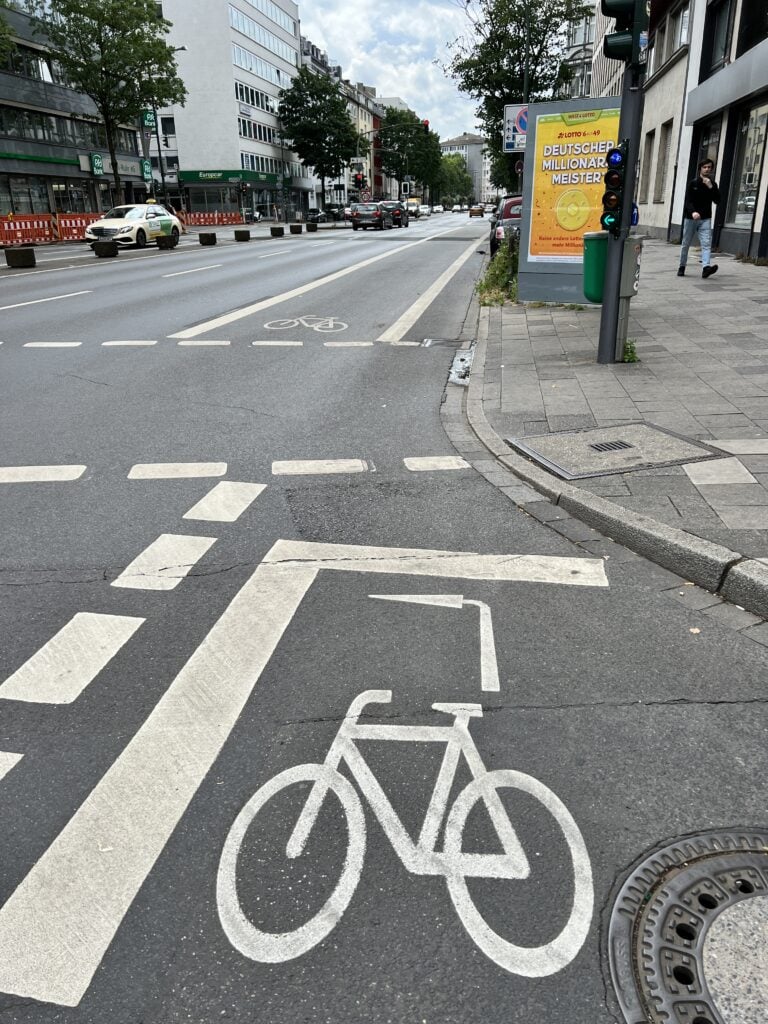
2. Make A Left Turn With A Bike Path Without Road Markings
If you are cycling on a road without a dedicated bike path or with a bike path without designated left turn road markings, you should signal with your left arm that you want to turn left soon.
Before moving to the left of the lane, be sure to look over your left shoulder to make sure the car behind you recognized your signal and slowed down to let you cross the lane. Observe the oncoming traffic and turn to the left once it is clear.
Respect Priority Signs & Rules
On Germany’s roads, especially in towns and cities, a lane coming from the right at an intersection always has the right of way. So even without a ‘stop’ sign, you need to slow down and stop should another car, motorcycle, or bicycle be coming from the right. We explain this rule and its exceptions in our video below.
4. General cycling conduct in Germany
Next to knowing where to ride your bike and how to make turns on German streets, there are some important general cycling rules you need to know.
Follow Dedicated Bike Traffic Lights
If you are on a bike path, you will sometime have designated bike traffic lights. Be sure to follow them as they override pedestrian or car traffic lights on some streets.
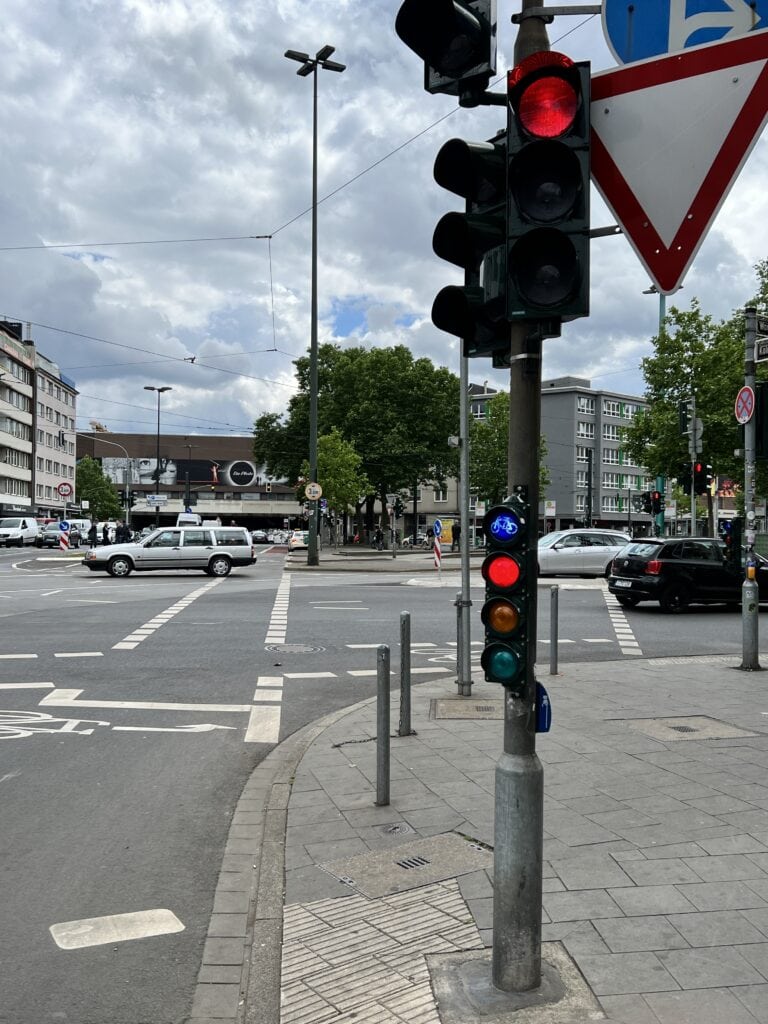
Cycle In Single File
If you are cycling around town with a friend or two, you should ride in a row and not next to each other to leave space for other traffic participants.
Always Overtake From The Left
Whenever you would like to take over another cyclist or go around a parked car (yes, unfortunately, delivery cars sometimes park on the bike paths), you should always do so from the left.
Never take other cyclists or pedestrians over from the right, as you won’t be expected from that side and might scare people and cause an accident.
If the bike path is congested or it is particularly tight, you can announce yourself with a friendly ring of your bell.
Cycle With Both Hands On The Handlebar
You should continuously cycle with both hands on the handlebar. Cycling free-handed might be cool and a great balance exercise, but it is highly dangerous in traffic.
You should also not hold your smartphone in one hand. You can either get a phone holder for your handlebar or listen to directions via one earplug.
Cycling In Germany With Headphones Is Allowed
You must always be able to listen to the surrounding traffic sounds, and thus you should never have music blasting through headphones while cycling. However, it is not forbidden to wear headphones, as long as their sound is so low that you can still hear your surroundings.
We suggest that if you want to listen to soft music, hold phone calls or listen to directions while cycling, you do so with only one earplug in one ear.
Only One Person Per Bike
Unless you are riding a tandem bike, only one person is allowed to ride a regular bicycle. This implies that you should not give someone else a lift on your rack or bicycle frame.
Children Need Special Child Seat Or Trailer
Since the bicycle serves as a general means of transportation, lots of Germans also carry their children on their bikes. You need to use a special child seat for that purpose or ride a cargo bike with child seat belts built-in. These types of bikes are very trendy currently in Germany, as they also allow you to carry heavier cargo and really aim to substitute the use of cars in cities.
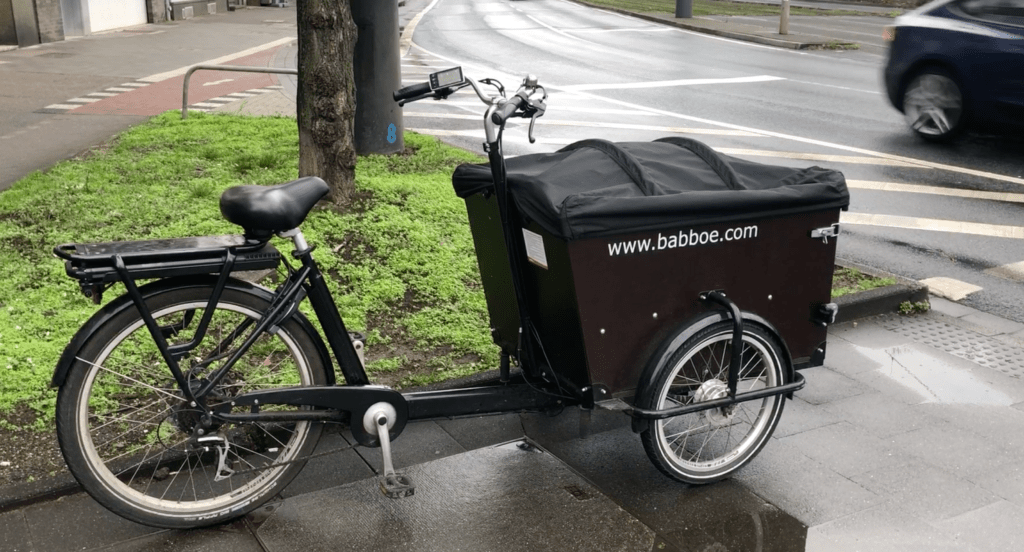
You can also check our video on cycling rules in Germany below for practical examples.
If you disrespect any of these traffic laws, you can be fined between 5 and 180 euros. You can find an overview of the individual fines on the website of the German cyclists association.
How to lock your bike in Germany
Since cycling in Germany is so popular, bike theft, unfortunately, is as well. The first step in preventing your bike to get stolen is to lock it with a high-quality lock against a bike rack, traffic sign pole, or light pole so that it can’t be carried away.
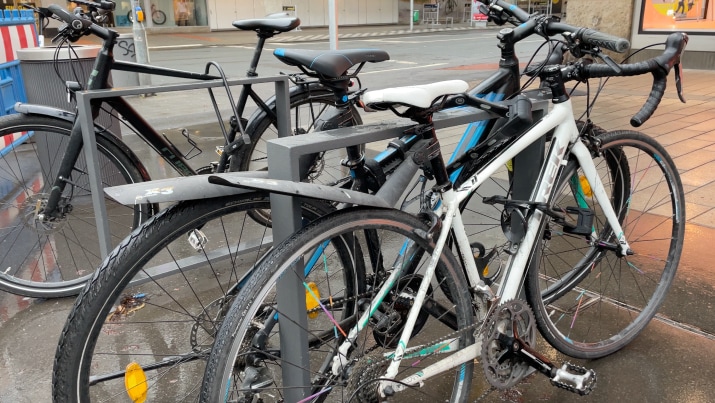
- The Bike Lock we use since 2015
- Security Level 9 from 15
Get bicycle theft insurance
According to German Insurance Association, there were over 260.000 bike thefts in Germany in 2020, and 55% of Germans have bike theft insurance.
If you have invested in a good bike and you would not be able to purchase it immediately if it gets stolen, then we highly recommend that you consider getting bicycle theft insurance. They are not expensive and really are worthwhile if you just invested or are going to invest in a quality bike. We have an in-depth guide on bike theft and the best insurance providers.
- Covers theft, burglary, vandalism as well as tear & wear
- Covers bikes for up to 10.000 euros
- Pays reinstatement value of your new bike
- No age restrictions on your bike
Read Our Related Guide
Do you need a bicycle license in Germany?
No, you don’t need a license to ride a traditional bicycle in Germany. However, if you want to ride a pedelec, you will require a small motorcycle license (class AM) if the pedelec motor has more than 250 watts and can drive faster than 25 km/h or if the e-bike can drive solely with the motor without pedaling.
The AM class license is included in the regular B class car license if you already have a German driving license.
Read Our Related Guide
Is it compulsory to wear a helmet when cycling in Germany?
No, it is not compulsory to wear a helmet when riding a regular bike in Germany. However, you do need to wear a helmet by law if you ride a bicycle with a motor that can go faster than 25 km/h or if the bike can drive solely with the motor without pedaling.
Rules for motorized bicycles (e-bike and pedelec) in Germany
There is a distinct difference between an e-bike and a pedelec from a legal point of view.
A pedelec (pedal electric cycle) has a supportive electronic motor, which helps you up hills or through headwinds. The electric motor only works in combination with your pedaling.
An e-bike (electronic bicycle) carries an electronic motor that functions without your pedaling and hence no longer gets considered a bicycle but a motorized cycle.
Here is an overview of the requirements per e-bike type:
Pedelecs up to 25km/h
- legally treated like bicycles
- pedaling and motor work in symbiosis and progressive, the motor does not work alone
- max 250-watt motor
- must drive on the cycling lane
S-Pedelecs up to 45km/h
- legally treated as a small motorcycle
- pedaling and motor work in symbiosis and progressive, the motor does not work alone
- license class AM (small motorcycles) is needed (which is included when you get a German car class B license)
- vehicle insurance is needed (such as the Moped Insurance from Adam Riese)
- must drive on the road – not allowed on the cycling lane
- helmet is obligatory
E-Bikes up to 25km/h
- legally treated like a moped (motor assisted bicycle)
- they can drive solely with the motor without pedaling
- M license is needed (Mofabescheinigung)
- vehicle insurance is needed (such as the Moped Insurance from Adam Riese)
- outside of cities, allowed to use bike lanes – inside cities only if a special sign allows mopeds
- helmet is obligatory
E-Bikes up to 45km/h
- legally treated as a small motorcycle
- they can drive solely with the motor without pedaling
- license class AM (small motorcycles) is needed
- vehicle insurance is needed (such as the Moped Insurance from Adam Riese)
- must drive on the road – not allowed on the cycling lane
- helmet is obligatory
What to do in case of an accident?
In case you get into an accident while cycling, you should follow these steps:
- Secure the scene of the accident and help the injured.
- In case of bad injuries, call 112 for an ambulance.
- Should anyone have gotten injured or there is a possibility for injuries that only show a few days later (e.g., back pain), call the police at 110. Also, call the police if there is a dispute between the involved parties on how the accident occurred.
- Take pictures of the scene of the accident and other vehicles involved, including their license plates.
- If damages and injuries are minor, try to clear the scene of the accident so that ongoing traffic can continue.
- Write down the names, addresses, and phone numbers of any witnesses.
- Fill in an accident report form (cars or police usually carry them with them) together with the other party involved. This form is no admittance to a fault but simply to collect essential data, such as names, addresses, license plates, liability insurance numbers, and contact details for the car driver and the cyclists, if they have one.
- In case you have damages on your bike, follow up with the other party’s insurance company for reimbursement. In case your bike got heavily damaged, you might want to have an expert evaluate the repair cost.
- In case you have suffered injuries, you should contact a lawyer to help you with compensation and settlement. This is the worst case and one where legal insurance might be useful.
It is super important to have personal liability insurance in Germany, especially as a cyclist. We have a complete guide explaining why you need liability insurance in Germany and which one to get.
- from €2,44
- 100% in English and digital
- Cover up to 50 million euros
- Cancel anytime
Conclusion
As a cyclist in Germany, you have to follow the general traffic rules just as if you were driving a car and always respect others who are using the same roads as you are. We hope you feel better prepared to navigate the German roads after reading our guide on the cycling rules in Germany.
Happy cycling! 🚴








